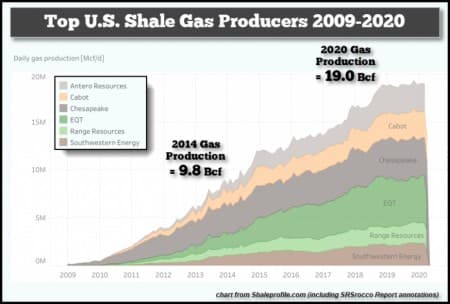Over the past half decade, the natural gas sector has earned itself the dubious distinction as the place where money goes to die. Few sectors of the U.S. market have been destroying shareholder value faster than stocks of shale gas producers.
After peaking in 2014, stocks of leading U.S. shale gas companies have badly cratered despite a sharp increase in production. According to Shaleprofile.com, shale gas production by the six leading companies in the sector has nearly doubled from 9.8 billion cubic feet (Bcf/d) in 2014 to 19 Bcf/d in 2020.
Unfortunately, this has hardly reflected on their share performance, with most tumbling more than 90% over the timeframe mainly due to their inability to turn a profit. The wider sector has not fared any better, with the United States Natural Gas Fund (UNG) tumbling 75% since 2018.
The disappointing performance shows no signs of moderating. Many are deeply in the red in the year-to-date thanks to stubborn supply overhang, a mild winter and a hobbled global economy due to the Covid-19 crisis.
Others, such as Chesapeake Energy and Whiting Petroleum, have filed for Chapter 11 with dozens more hanging on for dear life after natural gas prices collapsed to multi-decade lows.

Source: Investing.com
Given this backdrop--coupled with the fact that some experts are warning that the sector might take years to reset--the majority of investors might prefer to steer clear of anything to do with natural gas or LNG.
On the opposite side of the spectrum, the U.S. shale gas sector might provide just the right bottom fishing opportunities for bold contrarian investors willing to bet on a rebound in natural gas prices.
In its latest Short-Term Energy Outlook (STEO), the EIA has predicted that natural gas prices will begin to recover later in 2020, thanks to rising demand as economies across the globe gradually reopen as well as due to declining production.
The EIA sees Henry Hub spot prices recovering from the current $1.72/MBtu to an average of $2.46/MMBtu during Q4 2020. The energy watchdog has tapped the recovery to continue over the next year with gas prices averaging $3.10/MMB over the course of 2021 as production continues to fall.
Here are 4 shale gas stocks that might be good candidates for playing a natural gas rebound:
#1 EQT Corporation
YTD Returns: 14.6%
Headquartered in Pittsburgh, Pennsylvania, EQT Corporation (NYSE:EQT) is the largest U.S. shale gas producer. EQT Corp. engages in the production, gathering, and transmission of shale gas in the Appalachian area with 2019 production clocking in at about 4.1 bcf/d.
In May, EQT announced that it will temporarily curtail ~1.4B cfe/day of gross production, due to low natural gas prices. This means the company’s Q2 production is likely to clock in at 315B-335B cfe, below its previous guidance of 360B-380B cfe. Despite the drastic production cuts, EQT has said it expects no changes to its full-year production and financial guidance.
Early this month, JPMorgan chimed in with a bullish note on EQT saying the cancellation of the Atlantic Coast Pipeline could lead to cash flow upside as high as $68M for EQT. JPM has a $17 price target for the shares (~38% upside to current price).
#2 Range Resources Corporation
YTD Returns: 28.9%
Operating in the gas-rich Marcellus Formation in Texas, Range Resources (NYSE:RRC) is the 8th largest U.S. shale gas producer with 2019 production clocking in at about 2.3 bcf/d and 18.191 trillion cubic feet of natural gas equivalent in proved reserves.
The shares have been doing well mainly due to the company’s better outlook compared to its peers. Q1 revenue of $693.92M represented a -7.2% Y/Y growth and beat Wall Street’s consensus by $85.47M while GAAP EPS of $0.58 beat by $0.55.
Earlier this month, investment firm MKM Partners upgraded RRC from a "neutral" rating to a "buy" rating with a $9 price target (~42% upside to current price), making it the only analyst to rate RRC a buy ( 7 Sell, 12 Hold). Investors are advised to tread carefully with short interest currently hovering at ~21% of outstanding shares.
#3 Cabot Oil & Gas Corporation
YTD Returns: -0.23%
Texas-based Cabot Oil & Gas Corporation (NYSE:COG) is the 4th largest shale gas producer in the United States. COG operates in the Marcellus Formation where it owns 173,000 net acres sitting on12.903 trillion cubic feet equivalent of proved reserves, all of which is natural gas.
During its Q1 earnings call, COG’s management revealed that it had hedged its April-October gas production at $2.10-$2.27/MMBtu but had chosen not to hedge 2021 production because it believed the market was underestimating the potential undersupply of natural gas. The company pointed out that a mere $0.10 improvement in the annual NYMEX price in 2021 would imply a $55 million improvement in the company’s incremental free cash flow.
In June, Stifel cut COG to sell on valuation concerns but remained positive on the company’s acreage quality, management and execution.
#4 Antero Resources
YTD Returns: -6.7%
Colorado-based Antero Resources (NYSE:AR) is the 3rd largest U.S. natural gas producer, pumping 3.2 bcf/d of natural gas from the Appalachian Basin where it owns 612,000 net acres of oil and gas properties sitting on 18,893 billion cubic feet (535 billion cubic meters) of estimated proved reserves.
The company has been plagued by worries regarding its ballooning debt which has now reached $6.2B, giving the company a debt-to-equity ratio of 0.95. However, the shares have climbed nearly 12% over the past two weeks after the company managed to clinch an overriding royalty interest transaction with Sixth Street Partners that will pump an additional $402M in its coffers. The deal will allow AR to pay down debt while also retaining the long-term upside of its core acreage position.
Nevertheless, short interest remains high at nearly 20%.
By Alex Kimani for Oilprice.com
More Top Reads From Safehaven.com:
















